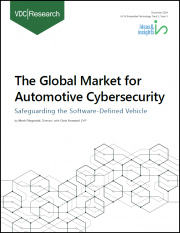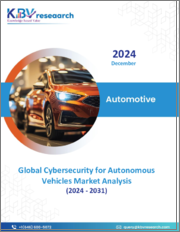
|
시장보고서
상품코드
1355035
세계의 자동차 사이버 보안 시장 평가 : 컴포넌트별, 조직 규모별, 차량 유형별, 추진 유형별, 용도별, 지역별, 기회 및 예측(2016-2030년)Automotive Cyber Security Market Assessment, By Component, By Organization Size, By Vehicle Type, By Propulsion Type, By Application, By Region, Opportunities and Forecast, 2016-2030F |
||||||
세계 자동차 사이버 보안 시장은 최근 몇 년 동안 큰 성장세를 보였으며, 2022년 매출은 약 50억 3,000만 달러로 2030년까지 152억 달러에 달할 것으로 예상되며, 2023-2030년 CAGR 14.8%로 성장할 것으로 예측됩니다.
커넥티드 카의 보급 확대
자동차 산업에서 커넥티드 카의 확산은 사이버 보안 시장에 큰 영향을 미치고 있습니다. 인포테인먼트 시스템, 무선 통신, 텔레매틱스, V2V 통신, V2I 통신 등의 기능으로 인해 자동차가 점점 더 많이 연결됨에 따라 잠재적인 사이버 위협과 취약점의 공격 대상이 확대되고 있습니다. 커넥티드 차량은 원격 해킹, 차량 시스템에 대한 무단 액세스, 데이터 침해 등 새로운 사이버 공격 수단을 제공합니다. 차량 내 부품들이 서로 연결되면 악의적인 행위의 잠재적 침투 통로가 될 수 있습니다. 커넥티드 차량의 도입으로 안전한 OTA 소프트웨어 업데이트를 쉽게 구현할 수 있게 되었습니다. 이러한 업데이트는 취약점을 해결하고 새로운 위협으로부터 차량을 보호하기 위해 패치를 적용하는 데 매우 중요합니다.
예를 들어, VicOne은 2023년 5월 고객의 데이터 프라이버시를 보호하기 위해 OEM을 위해 특별히 설계된 혁신적인 스마트 콕핏 보호 솔루션(Smart Cockpit Protection Solutions)을 발표했습니다. 인포테인먼트(IVI) 시스템 내 데이터 프라이버시를 보장하는 스마트 콕핏 시큐리티 앱(Smart Cockpit Security App)과 OEM 카 컴패니언 앱에 강력한 보호 기능을 제공하는 스마트 콕핏 모바일 SDK(Smart Cockpit Mobile SDK)의 두 가지 주요 구성요소로 구성됩니다. 이러한 솔루션을 VicOne의 기존 사이버 보안 제품과 통합함으로써 OEM은 기본 시스템 수준에서 애플리케이션 수준까지 견고하고 다층적인 사이버 보안 방어의 이점을 누릴 수 있습니다.
사이버 공격에 취약한 전기자동차
전기자동차(EV)의 보급으로 사이버 공격에 대한 취약성이 증가하고 있습니다. 자동차 산업이 전기 추진 시스템으로 전환하면서 복잡한 소프트웨어, 커넥티비티, 데이터 교환에 대한 의존도가 높아짐에 따라, EV는 전력 분배, 배터리 관리, 회생 제동 및 기타 중요한 기능을 관리하는 정교한 소프트웨어 시스템에 크게 의존하고 있습니다. 의존하고 있습니다. 이 소프트웨어의 복잡성으로 인해 공격의 대상이 많아지고 잠재적인 사이버 침입의 입구가 늘어납니다. 일부 전기차에는 ADAS(첨단운전자보조시스템)와 자율주행 기능이 탑재되어 있습니다. 이러한 기능은 광범위한 센서 데이터와 통신에 의존하기 때문에 조작과 방해의 대상이 될 수 있습니다.
예를 들어, Elektrobit과 Argus Cyber Security는 2022년 9월 EB zoneo SwithCore Shield를 발표했습니다. 이 혁신적인 솔루션은 임베디드 침입탐지 방어(IDP) 기능을 차세대 자동차를 위한 고급 네트워크 관리 시스템에 통합하는 혁신적인 솔루션입니다. 이 협업은 Argus Ethernet 침입 탐지 및 방어 시스템(IDPS)이 탑재된 소형 임베디드 모듈을 제공합니다. 이 강력한 사이버 보안 세이프가드는 차량용 이더넷 및 네트워크용으로 설계되었으며, 차량용 E/E 아키텍처에 차량용 스위치 펌웨어로 원활하게 통합됩니다.
ADAS 구현으로 시장 성장 촉진
첨단운전자보조시스템(ADAS) 기능의 구현은 자동차 사이버 보안 시장의 성장을 촉진하는 요인으로 작용하고 있습니다. 자동차가 어댑티브 크루즈 컨트롤, 차선 이탈 경고, 자동 긴급 제동 등의 기능을 포함한 첨단 ADAS 기술을 구현함에 따라 자동차의 복잡성과 연결성은 비약적으로 증가하고 있습니다. 이러한 복잡성은 이러한 시스템의 안전과 기능을 손상시킬 수 있는 사이버 위협과 취약성에 대한 새로운 길을 열어줍니다. 이에 따라 자동차 업계는 ADAS 및 기타 차량 시스템을 보호하기 위한 사이버 보안 대책을 매우 중요하게 여기고 있습니다.
예를 들어, 전기차 제조업체 XPeng은 2022년 9월 중국 최초의 도시 주행 시나리오에 맞는 ADAS(첨단운전자보조시스템)를 발표했습니다. 이 회사는 City NGP ADAS를 공식적으로 발표했습니다. 이 시스템은 현재 광저우에서 파일럿 테스트를 진행하고 있으며, 처음에는 Tesla Model 3의 직접적인 경쟁자인 P5 전기 세단에 탑재될 예정이며, City NGP의 배포는 무선 업데이트 메커니즘을 통해 촉진될 것입니다.
이 보고서는 세계 자동차 사이버 보안 시장에 대해 조사 분석했으며, 시장 규모와 예측, 시장 역학, 주요 기업 현황과 전망 등을 전해드립니다.
목차
제1장 조사 방법
제2장 프로젝트 범위와 정의
제3장 자동차 사이버 보안 시장에 대한 COVID-19의 영향
제4장 러시아·우크라이나 전쟁의 영향
제5장 주요 요약
제6장 자동차 사이버 보안 시장 전망(2016-2030년)
- 시장 규모와 예측
- 금액
- 컴포넌트별
- 소프트웨어
- 서비스
- 조직 규모별
- 대기업
- 중소기업
- 차종별
- 승용차
- 상용차
- 추진 유형별
- ICE
- 전기
- 하이브리드
- 용도별
- ADAS·안전성
- 인포테인먼트
- 바디 일렉트로닉스
- 파워트레인
- 텔레매틱스
- 지역별
- 북미
- 유럽
- 남미
- 아시아태평양
- 중동 및 아프리카
- 시장 점유율 : 기업별(2022년)
제7장 자동차 사이버 보안 시장 전망 : 지역별(2016-2030년)
- 북미
- 시장 규모와 예측
- 컴포넌트별
- 조직 규모별
- 차종별
- 추진 유형별
- 용도별
- 미국
- 캐나다
- 멕시코
- 유럽
- 독일
- 프랑스
- 이탈리아
- 영국
- 러시아
- 네덜란드
- 스페인
- 터키
- 폴란드
- 남미
- 브라질
- 아르헨티나
- 아시아태평양
- 인도
- 중국
- 일본
- 호주
- 베트남
- 한국
- 인도네시아
- 필리핀
- 중동 및 아프리카
- 사우디아라비아
- 아랍에미리트
- 남아프리카공화국
제8장 시장 매핑(2022년)
- 컴포넌트별
- 조직 규모별
- 차종별
- 추진 유형별
- 용도별
제9장 거시적 환경과 산업 구조
- PESTEL 분석
- Porter's Five Forces 분석
제10장 시장 역학
- 성장 촉진요인
- 성장 억제요인(과제, 억제요인)
제11장 주요 기업 상황
- 시장 리더 상위 5개사 경쟁 매트릭스
- 시장 리더 상위 5개사 시장 매출 분석(2022년)
- 인수합병/합작투자(해당되는 경우)
- SWOT 분석(시장 진출 기업 5개사용)
- 특허 분석(해당되는 경우)
제12장 사례 연구(해당되는 경우)
제13장 주요 기업 전망
- Argus Cyber Security Ltd.
- Guardknox Cyber Technologies Ltd.
- Karamba Security Ltd.
- Upstream Security Ltd.
- Aptiv Global Operations Limited
- Nvidia Corporation
- Thales Group
- HARMAN International
- ETAS GmbH
- Broadcom, Inc.
제14장 전략적 추천사항
제15장 당사 소개와 면책사항
ksm 23.10.12Global automotive cyber security market has experienced significant growth in recent years and is expected to maintain a strong pace of expansion in the coming years. With projected revenue of approximately USD 5.03 billion in 2022, the market is forecasted to reach a value of USD 15.2 billion by 2030, displaying a robust CAGR of 14.8% from 2023 to 2030.
Automotive cybersecurity protects vehicles and their electronic systems from cyber threats and attacks. With the increasing connectivity and complexity of modern vehicles, including features such as infotainment systems, advanced driver assistance systems (ADAS), autonomous driving capabilities, and vehicle-to-vehicle (V2V) and vehicle-to-infrastructure (V2I) communication, the need for robust cybersecurity measures in the automotive industry has become paramount. The automotive cyber security market involves the technologies, solutions, and services designed to protect vehicles and their electronic systems from cyber threats and attacks. As vehicles become more connected and autonomous, the automotive industry's need for robust cybersecurity measures has grown significantly.
According to Upstream's 2023 Global Automotive Cybersecurity Report, the leading cyberattack vectors 2022 encompassed various areas, with telematics and application servers at the forefront, accounting for 35% of attacks. Following closely, remote keyless entry systems encountered 18%, 14% in electronic control units, 12% automotive and smart mobility APIs, 8% infotainment systems, 6% mobile applications, and 4% EV charging infrastructure.
Increasing Adoption of Connected Vehicles
The increasing adoption of connected vehicles in the automotive industry has significantly impacted the cybersecurity market. As vehicles become more connected, with features such as infotainment systems, wireless communication, telematics, and vehicle-to-vehicle (V2V) and vehicle-to-infrastructure (V2I) communication, the attacking surface for potential cyber threats and vulnerabilities has expanded. Connected vehicles introduce new avenues for cyberattacks, including remote hacking, unauthorized access to vehicle systems, data breaches, and more. As the components within a vehicle become interconnected, they become a potential entry point for malicious acts. The adoption of connected vehicles has facilitated the implementation of secure OTA software updates. These updates are crucial for addressing vulnerabilities and applying patches to protect vehicles against emerging threats.
For example, in May 2023, VicOne introduced its innovative Smart Cockpit Protection Solutions designed specifically for OEMs to safeguard their customers' data privacy. This comprehensive offering from VicOne comprises two key components: the Smart Cockpit Security App, which ensures the privacy of data within the in-vehicle infotainment (IVI) systems, and the Smart Cockpit Mobile SDK (software development kit), which provides robust protection for OEM car companion apps. By integrating these solutions with VicOne's existing cybersecurity offerings, OEMs can benefit from a robust and multi-layered cybersecurity defense spanning from the fundamental system level to the application layer.
Electric Vehicles to be More Vulnerable to Cyber Attacks
The growing adoption of electric vehicles (EVs) has introduced a heightened vulnerability to cyber-attacks. As the automotive industry shifts towards electric propulsion systems, the increased reliance on complex software, connectivity, and data exchange makes EVs more susceptible to cyber threats. EVs heavily depend on sophisticated software systems to manage power distribution, battery management, regenerative braking, and other critical functions. The complexity of this software increases the attack surface, providing more entry points for potential cyber intrusions. Some EVs have advanced driver assistance systems (ADAS) and autonomous capabilities. These features rely on extensive sensor data and communication, making them a potential target for manipulation or disruption.
For example, in September 2022, Elektrobit and Argus Cyber Security introduced the EB zoneo SwithCore Shield. This innovative solution integrates embedded intrusion detection and prevention (IDP) capabilities into advanced network management systems for next-generation vehicles. This collaborative effort presents a compact embedded module featuring the Argus Ethernet Intrusion Detection and Prevention System (IDPS). The robust cybersecurity safeguard is designed for automotive ethernet networks and seamlessly integrated as automotive-grade switch firmware within the vehicle's electrical and electronic (E/E) architectures.
Implementation of ADAS Propels Market Growth
Implementing Advanced Driver Assistance Systems (ADAS) capabilities is a driving force behind the growth of the automotive cybersecurity market. As vehicles are implementing advanced ADAS technologies, which include features like adaptive cruise control, lane departure warning, automatic emergency braking, and more, the complexity and connectivity within vehicles are exponentially rising. This complexity opens new avenues for potential cyber threats and vulnerabilities that could have compromised the safety and functionality of these systems. As a result, the automotive industry is greatly emphasizing cybersecurity measures to safeguard ADAS and other vehicle systems.
For instance, in September 2022, Electric automaker XPeng unveiled China's first advanced driver assistance system (ADAS) tailored for urban driving scenarios. The company officially introduced its City Navigation Guided Pilot (City NGP) ADAS. This system is currently undergoing pilot testing in Guangzhou, initially featuring on the P5 electric sedan-a direct competitor of the Tesla Model 3. The deployment of City NGP will be facilitated through an over-the-air update mechanism.
Government Initiatives
Government initiatives play a significant role in shaping the global automotive cybersecurity market. They are implementing and promoting various policies of network security at the global level. These initiatives often focus on data security, privacy regulations, and standardization to build trust and confidence among businesses and consumers. Government authorities are investing in cyber security infrastructure development, offering incentives, and creating supportive regulatory frameworks to encourage cloud adoption and stimulate innovation.
Recent research indicates that cybersecurity in the automotive sector will prompt substantial investments, surging from USD 4.9 billion in 2020 to USD 9.7 billion in 2030. The initiative of the UN Regulations framework is poised to drive innovation and foster economic prospects for a wide range of stakeholders, including suppliers, IT companies, specialized niche enterprises, and startups, especially within the software development and services market.
Impact of COVID-19
The COVID-19 pandemic significantly impacted various industries, including the cybersecurity sector in the automotive industry. The pandemic increased cyberattacks and security breaches as hackers exploited the uncertainties and vulnerabilities introduced by remote work arrangements and increased online activities. The pandemic disrupted supply chains, manufacturing, and research and development efforts, leading to delays in deploying new vehicles and technologies. This negatively impacted the integration of cybersecurity measures for vehicles and systems. Furthermore, the pandemic underscored cross-industry collaboration's importance in addressing cybersecurity challenges. As a result, companies and governments have increased their collaborative efforts to strengthen cybersecurity in the automotive sector, especially in Asia Pacific.
Impact of the Russia-Ukraine War
Russia-Ukraine war notably impacted the global automotive cyber security market. The conflict has led to concerns about data privacy, security, and geopolitical instability, prompting businesses to re-evaluate their automotive cyber security infrastructure. Automotive companies are becoming increasingly cautious about storing sensitive data in regions affected by the conflict, leading to a potential shift in cyber security service providers through cloud solutions for better control and risk management. Moreover, the war has disrupted internet connectivity in certain areas, affecting the reliability and accessibility of security cloud services. Additionally, geopolitical tensions have raised concerns about data sovereignty and compliance with international regulations. As a result, businesses focus on diversifying their cyber security infrastructure and exploring alternative markets to mitigate potential risks, ensuring uninterrupted operations and data protection.
Key Players Landscape and Outlook
The automotive cyber security market is witnessing a swift growth trajectory due to the increasing emphasis placed by companies worldwide on establishing advanced automotive cyber security infrastructure. Furthermore, the market expansion is greatly facilitated by the establishment of proper cloud infrastructure, along with significant investments made by companies to enhance research and development resources, engage in collaboration projects, bolster marketing efforts, and expand distribution networks. These factors collectively contribute to the rapid expansion of the market.
In February 2023, Elektrobit unveiled the immediate release of EB tresos 9, the latest version of its top-tier foundational software. The software empowers automotive manufacturers and suppliers to create effective electronic control units (ECUs) aligned with the latest AUTOSAR standard. The new iteration accommodates AUTOSAR R20-11, while seamlessly integrating the remarkable onboard intrusion-detection functionalities found in Argus CAN IDPS. Notably, Argus Cyber Security, recognized with the CES 2023 innovation award, is behind the development of these industry-leading intrusion-detection capabilities.
Table of Contents
1. Research Methodology
2. Project Scope & Definitions
3. Impact of COVID-19 on the Automotive Cyber Security Market
4. Impact of Russia-Ukraine War
5. Executive Summary
6. Automotive Cyber Security Market Outlook, 2016-2030F
- 6.1. Market Size & Forecast
- 6.1.1. By Value
- 6.2. By Component
- 6.2.1. Software
- 6.2.2. Services
- 6.2.2.1. Vehicle Risk Management
- 6.2.2.2. Vulnerability Analysis & Testing
- 6.2.2.3. Automotive Network Security
- 6.2.2.4. Others
- 6.3. By Organization Size
- 6.3.1. Large Enterprises
- 6.3.2. Small & Medium Enterprises
- 6.4. By Vehicle Type
- 6.4.1. Passenger Vehicles
- 6.4.2. Commercial Vehicles
- 6.5. By Propulsion Type
- 6.5.1. ICE
- 6.5.2. Electric
- 6.5.3. Hybrid
- 6.6. By Application
- 6.6.1. ADAS & safety
- 6.6.2. Infotainment
- 6.6.3. Body electronics
- 6.6.4. Powertrain
- 6.6.5. Telematics
- 6.7. By Region
- 6.7.1. North America
- 6.7.2. Europe
- 6.7.3. South America
- 6.7.4. Asia-Pacific
- 6.7.5. Middle East and Africa
- 6.8. By Company Market Share (%), 2022
7. Automotive Cyber Security Market Outlook, By Region, 2016-2030F
- 7.1. North America*
- 7.1.1. Market Size & Forecast
- 7.1.1.1. By Value
- 7.1.2. By Component
- 7.1.2.1. Software
- 7.1.2.2. Services
- 7.1.2.2.1. Vehicle Risk Management
- 7.1.2.2.2. Vulnerability Analysis & Testing
- 7.1.2.2.3. Automotive Network Security
- 7.1.2.2.4. Others
- 7.1.3. By Organization Size
- 7.1.3.1. Large Enterprises
- 7.1.3.2. Small & Medium Enterprises
- 7.1.4. By Vehicle Type
- 7.1.4.1. Passenger Vehicle
- 7.1.4.2. Commercial Vehicle
- 7.1.5. By Propulsion Type
- 7.1.5.1. ICE
- 7.1.5.2. Electric
- 7.1.5.3. Hybrid
- 7.1.6. By Application
- 7.1.6.1. ADAS & safety
- 7.1.6.2. Infotainment
- 7.1.6.3. Body electronics
- 7.1.6.4. Powertrain
- 7.1.6.5. Telematics
- 7.1.7. United States*
- 7.1.7.1. Market Size & Forecast
- 7.1.7.1.1. By Value
- 7.1.7.2. By Component
- 7.1.7.2.1. Software
- 7.1.7.2.2. Services
- 7.1.7.2.2.1. Vehicle Risk Management
- 7.1.7.2.2.2. Vulnerability Analysis & Testing
- 7.1.7.2.2.3. Automotive Network Security
- 7.1.7.2.2.4. Others
- 7.1.7.3. By Organization Size
- 7.1.7.3.1. Large Enterprises
- 7.1.7.3.2. Small & Medium Enterprises
- 7.1.7.4. By Vehicle Type
- 7.1.7.4.1. Passenger Vehicle
- 7.1.7.4.2. Commercial Vehicle
- 7.1.7.5. By Propulsion Type
- 7.1.7.5.1. ICE
- 7.1.7.5.2. Electric
- 7.1.7.5.3. Hybrid
- 7.1.7.6. By Application
- 7.1.7.6.1. ADAS & safety
- 7.1.7.6.2. Infotainment
- 7.1.7.6.3. Body electronics
- 7.1.7.6.4. Powertrain
- 7.1.7.6.5. Telematics
- 7.1.8. Canada
- 7.1.9. Mexico
- 7.1.1. Market Size & Forecast
All segments will be provided for all regions and countries covered
- 7.2. Europe
- 7.2.1. Germany
- 7.2.2. France
- 7.2.3. Italy
- 7.2.4. United Kingdom
- 7.2.5. Russia
- 7.2.6. Netherlands
- 7.2.7. Spain
- 7.2.8. Turkey
- 7.2.9. Poland
- 7.3. South America
- 7.3.1. Brazil
- 7.3.2. Argentina
- 7.4. Asia-Pacific
- 7.4.1. India
- 7.4.2. China
- 7.4.3. Japan
- 7.4.4. Australia
- 7.4.5. Vietnam
- 7.4.6. South Korea
- 7.4.7. Indonesia
- 7.4.8. Philippines
- 7.5. Middle East & Africa
- 7.5.1. Saudi Arabia
- 7.5.2. UAE
- 7.5.3. South Africa
8. Market Mapping, 2022
- 8.1. By Component
- 8.2. By Organization Size
- 8.3. By Vehicle Type
- 8.4. By Propulsion Type
- 8.5. By Application
9. Macro Environment and Industry Structure
- 9.1. PESTEL Analysis
- 9.1.1. Political Factors
- 9.1.2. Economic System
- 9.1.3. Social Implications
- 9.1.4. Technological Advancements
- 9.1.5. Environmental Impacts
- 9.1.6. Legal Compliances and Regulatory Policies (Statutory Bodies Included)
- 9.2. Porter's Five Forces Analysis
- 9.2.1. Supplier Power
- 9.2.2. Buyer Power
- 9.2.3. Substitution Threat
- 9.2.4. Threat from New Entrant
- 9.2.5. Competitive Rivalry
10. Market Dynamics
- 10.1. Growth Drivers
- 10.2. Growth Inhibitors (Challenges, Restraints)
11. Key Players Landscape
- 11.1. Competition Matrix of Top Five Market Leaders
- 11.2. Market Revenue Analysis of Top Five Market Leaders (in %, 2022)
- 11.3. Mergers and Acquisitions/Joint Ventures (If Applicable)
- 11.4. SWOT Analysis (For Five Market Players)
- 11.5. Patent Analysis (If Applicable)
12. Case Studies (If applicable)
13. Key Players Outlook
- 13.1. Argus Cyber Security Ltd.
- 13.1.1. Company Details
- 13.1.2. Key Management Personnel
- 13.1.3. Products & Services
- 13.1.4. Financials (As reported)
- 13.1.5. Key Market Focus & Geographical Presence
- 13.1.6. Recent Developments
- 13.2. Guardknox Cyber Technologies Ltd.
- 13.3. Karamba Security Ltd.
- 13.4. Upstream Security Ltd.
- 13.5. Aptiv Global Operations Limited
- 13.6. Nvidia Corporation
- 13.7. Thales Group
- 13.8. HARMAN International
- 13.9. ETAS GmbH
- 13.10. Broadcom, Inc.
Companies mentioned above DO NOT hold any order as per market share and can be changed as per information available during research work



















